Toner for developing latent electrostatic images, developer, developer container housing developer therein, process cartridge, image forming apparatus and image forming method
- Summary
- Abstract
- Description
- Claims
- Application Information
AI Technical Summary
Benefits of technology
Problems solved by technology
Method used
Image
Examples
preparation example 1
Synthesis of Crystalline Polyester Resin 1
[0203]A 5 L four-neck flask equipped with a nitrogen-introducing pipe, a drainpipe, a stirrer and a thermocouple was charged with 2,500 g of 1,12-decanediol, 2,330 g of 1,8-octanedioic acid, and 4.9 g of hydroquinone, and the mixture was allowed to react at 180° C. for 20 hours. Subsequently, the mixture was heated to 200° C. and allowed to react for 6 hours, followed by reacting for 10 hours at 8.3 kPa to thereby obtain Crystalline Polyester Resin 1. The thermal properties (melting point) measured by DSC, and the weight average molecular weight (Mw) measured by GPC of the obtained Crystalline Polyester Resin 1 are shown in Table 1.
preparation example 2
Synthesis of Crystalline Polyester Resin 2
[0204]A 5 L four-neck flask equipped with a nitrogen-introducing pipe, a drainpipe, a stirrer and a thermocouple was charged with 2,500 g of 1,12-decanediol, 1,930 g of 1,8-octanedioic acid, 300 g of fumaric acid, and 4.9 g of hydroquinone, and the mixture was allowed to react at 180° C. for 16 hours. Subsequently, the mixture was heated to 200° C. and allowed to react for 8 hours, followed by reacting for 9 hours at 8.3 kPa to thereby obtain Crystalline Polyester Resin 2. The thermal properties (melting point) measured by DSC, and the weight average molecular weight (Mw) measured by GPC of the obtained Crystalline Polyester Resin 2 are shown in Table 1.
preparation example 3
Synthesis of Crystalline Polyester Resin 3
[0205]A 5 L four-neck flask equipped with a nitrogen-introducing pipe, a drainpipe, a stirrer and a thermocouple was charged with 2,500 g of 1,12-decanediol, 2,330 g of 1,8-octanedioic acid, and 6.9 g of hydroquinone, and the mixture was allowed to react at 180° C. for 10 hours. Subsequently, the mixture was heated to 200° C. and allowed to react for 4 hours, followed by reacting for 5 hours at 8.3 kPa to thereby obtain Crystalline Polyester Resin 3. The thermal properties (melting point) measured by DSC, and the weight average molecular weight (Mw) measured by GPC of the obtained Crystalline Polyester Resin 3 are shown in Table 1.
PUM
| Property | Measurement | Unit |
|---|---|---|
| Temperature | aaaaa | aaaaa |
| Temperature | aaaaa | aaaaa |
| Temperature | aaaaa | aaaaa |
Abstract
Description
Claims
Application Information
 Login to View More
Login to View More - R&D
- Intellectual Property
- Life Sciences
- Materials
- Tech Scout
- Unparalleled Data Quality
- Higher Quality Content
- 60% Fewer Hallucinations
Browse by: Latest US Patents, China's latest patents, Technical Efficacy Thesaurus, Application Domain, Technology Topic, Popular Technical Reports.
© 2025 PatSnap. All rights reserved.Legal|Privacy policy|Modern Slavery Act Transparency Statement|Sitemap|About US| Contact US: help@patsnap.com



